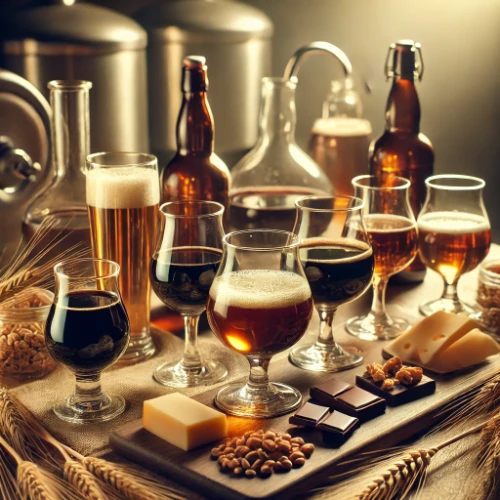Non-alcoholic malts offer a unique sensory experience that deserves to be fully appreciated. Whether you are a beginner or an experienced enthusiast, this Malt Tasting Guide will help you refine your tasting skills and savor every sip of these complex and flavorful beverages. Learn how to host your own malt tasting.
Preparation for the Tasting: Setting the Scene
Before starting your malt tasting, it’s essential to create the right environment. Find a quiet space with natural light and no strong odors that could interfere with the sensory experience. Your surroundings should allow you to focus on the malt’s visual, olfactory, and taste characteristics.
Choosing the Right Glass for Your Malt Tasting
The glass you choose can significantly influence your malt tasting experience. A clear glass, preferably tulip-shaped or a wine glass, is ideal because it enhances the ability to observe the color and effervescence. These shapes also concentrate the aromas, making the malt’s bouquet more intense. Explore how malt flavors enhance your tasting experience.
Ideal Temperature for Serving Non-Alcoholic Malts
Temperature plays a key role in how well you can perceive the flavors and aromas during a malt tasting. Serve non-alcoholic malts between 7°C and 10°C for optimal results. If served too cold, the flavors may be muted; if too warm, the drink may feel overly heavy and lose its refreshing qualities.
The Tasting Process: Engaging All Your Senses
Tasting non-alcoholic malts is not just about drinking. It’s a multisensory experience involving sight, smell, taste, and even touch. This Malt Tasting Guide will walk you through each step for a complete tasting experience, helping you fully appreciate the subtleties of the beverage.
Step 1: Visual Observation
The first step in any malt tasting is visual inspection. Hold the glass up to the light and observe the color, which can range from pale amber to deep brown, depending on the type of malt. Notice the clarity and the amount of foam that forms when poured. Clear, brilliant malts with a consistent foam indicate a well-brewed product.
Visual Tip: Clarity and brilliance are key indicators of quality in non-alcoholic malts.
Step 2: Aroma Evaluation
Once you’ve examined the appearance, it’s time to explore the malt’s aromas. Gently swirl the glass to release the bouquet and bring your nose close to the rim. Take a deep breath and note the variety of aromas, which can range from sweet, toasted malt to fruity or spicy notes, depending on the style.
Aroma Tip: The purity of aroma is a crucial factor in non-alcoholic malts. Pay close attention to subtle notes like caramel, vanilla, or even coffee.
Step 3: First Sip and Initial Taste
Take a small sip and let the malt cover your entire palate. Pay attention to the texture—whether it’s light or full-bodied—and focus on the initial flavors. Is it sweet, sour, or bitter? Can you detect any specific notes such as caramel, roasted barley, or dried fruits?
Taste Tip: Evaluate the harmony between sweetness, bitterness, carbonation, and any other distinctive flavors that emerge.
Step 4: Mouthfeel and Texture
The mouthfeel, or texture, is another important aspect of malt tasting. Consider how the malt feels on your palate. Is it smooth, creamy, or crisp? Is the carbonation lively or subtle? The mouthfeel can greatly influence your overall enjoyment of the malt.
Mouthfeel Tip: Softness and freshness in non-alcoholic malts are often associated with higher quality. A well-crafted malt will leave a clean and refreshing aftertaste.
Pairings to Enhance the Malt Tasting Experience
Pairing non-alcoholic malts with food can greatly enhance your tasting experience. The right pairing will complement the flavors of the malt and elevate the overall experience. Check out pairing ideas for festive occasions.
Non-Alcoholic Malts with Savory Foods
For savory pairings, non-alcoholic malts go well with foods like cured meats, smoked sausages, or mushroom dishes. These items can highlight the toasted and nutty notes often present in malt beverages.
Desserts and Non-Alcoholic Malts
When it comes to desserts, non-alcoholic malts are perfect with rich, sweet treats. Brownies, fruit cakes, and creamy flans are excellent choices. The malt’s caramel and toasted flavors pair wonderfully with the sweetness of these desserts.
Master the Art of Malt Tasting
Conducting a non-alcoholic malt tasting is an art form that can be enjoyed both alone and with others. By following this Malt Tasting Guide, you’ll gain a deeper appreciation for the subtle flavors, aromas, and textures that make non-alcoholic malts so enjoyable. Over time, you’ll refine your tasting skills and discover which malts best suit your personal preferences. Cheers to your next malt tasting adventure!
Suggested Related Links for Further Exploration
Here are additional links to include at the end of the post, enhancing internal linking and providing readers with more resources:
- Discover the Health Benefits of Non-Alcoholic Malt
Explore how non-alcoholic malt contributes to your overall well-being, from boosting digestion to improving mental clarity. - How to Host a Non-Alcoholic Malt Tasting at Home
Learn step-by-step tips for setting up a memorable malt tasting event in the comfort of your home. - Non-Alcoholic Malt Flavors: A Tasting Guide
Dive into the wide variety of malt flavor profiles and find your perfect match. - Pairing Non-Alcoholic Malt with Everyday Meals
Elevate your dining experience by discovering creative ways to pair malt with your favorite foods. - Non-Alcoholic Malt Recipes for Festive Celebrations
Get inspired by festive recipes that showcase the versatility of non-alcoholic malt.




